
In this edition of TV Time Machine, we are proud to interview artist and director Tom Wright, the man responsible for creating the paintings for Rod Serling’s Night Gallery. 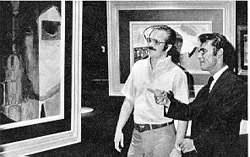 For decades, viewers and fans alike have been fascinated by these canvases that not only reflect the bizarre and horrific stories presented on Night Gallery, but also stand on their own as true works of art.
For decades, viewers and fans alike have been fascinated by these canvases that not only reflect the bizarre and horrific stories presented on Night Gallery, but also stand on their own as true works of art.
In these three audio interview segments, Tom Wright discusses every aspect of his extraordinary work on Night Gallery, his contribution to Universal Home Entertainment’s DVD release of Rod Serling’s Night Gallery Season Two, and his career producing and directing such shows as Millennium, Bones, and NCIS.
Listen to the interview below
Tom Wright Night Gallery audio interview Segment One-
In this segment, Tom talks about his early interest in art as a young man, producer Jack Laird, and working with Rod Serling. Mr. Wright also reveals his painting techniques and the step-by-step process he used to create his Night Gallery canvases.
Please click here to listen to audio (opens in popup)
“This little collector’s item here dates back a few hundred years to the British-Indian colonial period – proving only that sometimes the least likely objects can be filled with the most likely horror.”
“Our painting is called The Doll, and this one you’d best not play with.” 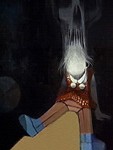
 “An unforgiving sea usually buries its secrets beneath itself. Warships and ocean liners, treasure galleons and submarines turn into rusting relics inside a watery locker, lost to memory. But occasionally there comes a floating unbidden reminder of disaster – like this lifeboat. The painting is called The Lone Survivor. We’ll put it in tow and see where she came from and why.”
“An unforgiving sea usually buries its secrets beneath itself. Warships and ocean liners, treasure galleons and submarines turn into rusting relics inside a watery locker, lost to memory. But occasionally there comes a floating unbidden reminder of disaster – like this lifeboat. The painting is called The Lone Survivor. We’ll put it in tow and see where she came from and why.”
 “Tonight’s first selection, a painting suggesting solitude, or at least solemnity as viewed during the midnight hour. It tells the tale of two young people caught inexorably in a recurring nightmare with a finale on the jolting side. Our painting, with the somewhat familiar face, is called Midnight Never Ends, and this is the Night Gallery.”
“Tonight’s first selection, a painting suggesting solitude, or at least solemnity as viewed during the midnight hour. It tells the tale of two young people caught inexorably in a recurring nightmare with a finale on the jolting side. Our painting, with the somewhat familiar face, is called Midnight Never Ends, and this is the Night Gallery.”
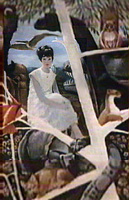 “There’s something rather remarkable in the scope of imagination peculiar to children. They project and dream and fantasize with beauty and simplicity and faith in a manner that somehow eludes us as we grow older. This is Brenda and Brenda has a playmate. It comes to her in part because of loneliness — and what I wish for you is that you never get that lonely.”
“There’s something rather remarkable in the scope of imagination peculiar to children. They project and dream and fantasize with beauty and simplicity and faith in a manner that somehow eludes us as we grow older. This is Brenda and Brenda has a playmate. It comes to her in part because of loneliness — and what I wish for you is that you never get that lonely.”
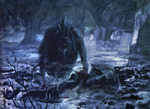 “H.P. Lovecraft, known to the aficionados of the occult – demonology, witchcraft – as a master storyteller, is responsible for our first selection in this museum of the frequently morbid. To you connoisseurs of the black arts, you’ll probably recognize it. It’s a painting that tells the story of a young artist who recruits his models from odd places. And the models are very odd indeed. The painter’s name, incidentally, is Pickman. The title is Pickman’s Model. And where else would you see a story like this except in the Night Gallery?”
“H.P. Lovecraft, known to the aficionados of the occult – demonology, witchcraft – as a master storyteller, is responsible for our first selection in this museum of the frequently morbid. To you connoisseurs of the black arts, you’ll probably recognize it. It’s a painting that tells the story of a young artist who recruits his models from odd places. And the models are very odd indeed. The painter’s name, incidentally, is Pickman. The title is Pickman’s Model. And where else would you see a story like this except in the Night Gallery?”
 “A dead man splattered on a concrete walk. Not the most appetizing of scenes and not the pleasantest of stories, but if you’re interested remotely in homey homicides, this may be your bag. We call it The Late Mr. Peddington.”
“A dead man splattered on a concrete walk. Not the most appetizing of scenes and not the pleasantest of stories, but if you’re interested remotely in homey homicides, this may be your bag. We call it The Late Mr. Peddington.”
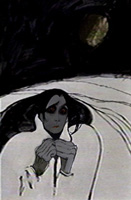 “In the general generic area of costume jewelry, note girl, and note expression. Obviously a lady much disturbed by whatever little bauble she has recently been the recipient of. Said sentence improperly ending on a preposition … but this story ending on a much more deadly note than that. “We call it A Feast of Blood.”
“In the general generic area of costume jewelry, note girl, and note expression. Obviously a lady much disturbed by whatever little bauble she has recently been the recipient of. Said sentence improperly ending on a preposition … but this story ending on a much more deadly note than that. “We call it A Feast of Blood.”
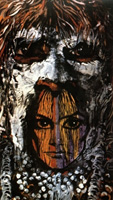 “There are horror stories and horror stories, elements of terror that take myriad forms. But this item has a built-in terror which can refrigerate even the most dispassionate amongst us. It has to do with a little beastie known as an earwig, a small bug that crawls into the human ear. And while inside it doesn’t whisper sweet nothings – it performs quite another function. Offered to you now on Night Gallery, a brand new nightmare which we call The Caterpillar.”
“There are horror stories and horror stories, elements of terror that take myriad forms. But this item has a built-in terror which can refrigerate even the most dispassionate amongst us. It has to do with a little beastie known as an earwig, a small bug that crawls into the human ear. And while inside it doesn’t whisper sweet nothings – it performs quite another function. Offered to you now on Night Gallery, a brand new nightmare which we call The Caterpillar.”
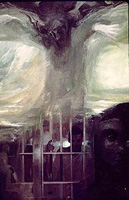 “Now here you have a study in penology – man imprisoned by his fellow man, caged in a barred cubicle and left alone far too long to contemplate both his sin and his sanity. This painting is called Finnegan’s Flight. It touches upon prisons, hypnosis and the soaring wings of imagination – but as to the latter, a small warning: imagination can be a double-edged thing. It can take you out of the humdrum realities, but it can also fly you to a place much less pleasant. May I introduce to you now Mr. Finnegan in his first and last appearance in the Night Gallery.”
“Now here you have a study in penology – man imprisoned by his fellow man, caged in a barred cubicle and left alone far too long to contemplate both his sin and his sanity. This painting is called Finnegan’s Flight. It touches upon prisons, hypnosis and the soaring wings of imagination – but as to the latter, a small warning: imagination can be a double-edged thing. It can take you out of the humdrum realities, but it can also fly you to a place much less pleasant. May I introduce to you now Mr. Finnegan in his first and last appearance in the Night Gallery.”
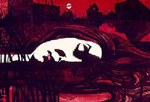 “In a color scheme of blood-red sky with corpse-white moon, this, we tell you up front, is a story of vampires. And of course this must conjure up images of Bela Lugosi and Christopher Lee, somewhat frigid, malevolent, monstrous creatures. But reserve such all-conclusive judgment of the living dead until you hear the story of a particular vampire, the kind you might find in a place like this, the Night Gallery.” From Death on a Barge.
“In a color scheme of blood-red sky with corpse-white moon, this, we tell you up front, is a story of vampires. And of course this must conjure up images of Bela Lugosi and Christopher Lee, somewhat frigid, malevolent, monstrous creatures. But reserve such all-conclusive judgment of the living dead until you hear the story of a particular vampire, the kind you might find in a place like this, the Night Gallery.” From Death on a Barge.
-
Laura
-
Mike Czosnek
-
Mike Czosnek
-
Pam Sterling-Seitz
-
Pam






